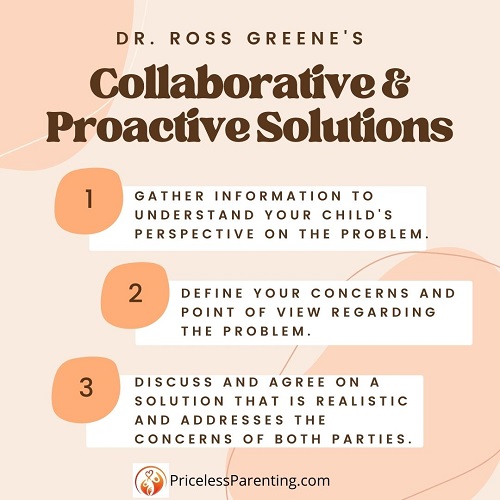Resolving Problems Using Collaborative & Proactive Solutions
by Kathy Slattengren, M. Ed., Priceless Parenting (sign up for monthly parenting newsletter and receive 20+ printable charts for kids and parents)

Do your children have challenging behaviors that keep reoccurring? If so, you probably have tried numerous things that haven't worked: time outs, grounding, withholding privileges, taking away toys, taking away the computer, TV or cellphone, and talking about the problem. Nothing has helped!
By definition, challenging behavior is difficult to solve. The reason nothing has worked is because the underlying cause of the problem has not been addressed. The trick is figuring out the root cause of the problem behavior.
Three Approaches to Solving Problem Behavior
Dr. Ross Greene has worked extensively with kids who are acting out at home and school. Over the years he has developed an approach that leads to success with most of these kids.
He discusses three options to misbehavior in his book
Raising Human Beings. He refers to these options as Plan A, Plan B and Plan C.
Plan A – Announcing the Solution
You solve the problem by letting your child know what is going to happen. You make the decision based on your expertise without your child’s input. Greene explains “Plan A involves solving a problem unilaterally, and it’s very popular. When you solve a problem using Plan A, you are the one deciding the solution to a given unsolved problem, and you’re imposing that solution on your child.”
For example, you might say things like
- “Since you are having trouble getting ready in the morning on time, from now on I want you to pick out your clothes the night before.”
- “You need to show me your completed homework every night until you bring your grades up.”
- “I’ve decided that your homework must be done before any TV or computer time.”
While it is tempting to try to force children to behave in a certain way, these attempts often fail. Children realize that you are trying to control their behavior and may respond by doing just the opposite of what you'd like.
Plan A increases the chances that your child will react poorly instead of complying. Commanding a child to do something often backfires.
Plan C – Consciously Deciding to Ignore the Behavior for Now
This approach involves deciding to drop the problem for now. If your child has a number of challenging behaviors, you may decide to delay dealing with one behavior in order to focus on a more important one. Greene writes “Plan C involves modifying, adapting, or setting aside an unsolved problem completely, at least temporarily. It can also involve holding off on helping to see if your child can solve a given problem independently.”
For example, if your child is refusing to take a jacket to school even though it's cold out, you may decide to let this go for now because you want to focus on the bigger issue of getting to school on time.
Handling one issue at a time sets you up for success. Once one problem is solved, it's easier to solve the next one.
Plan B – Brainstorming Using Collaborative & Proactive Solutions
Plan B takes the most time but also has the highest probability of success. When you use Plan B, you work with your child to find a solution to the problem. You are typically the one approaching your child to discuss the problem. You want to open up the discussion at a time when you and your child both have enough energy and the problem is not occurring.
In Raising Human Beings, Greene describes the three steps in the Collaborative & Proactive Solutions process as:
- “The Empathy step involves gathering information from your child to understand her concern, perspective, or point of view on a given unsolved problem.
- The Define-Adult-Concerns step involves communicating your concern, perspective, or point of view on the same problem.
- The Invitation step is when you and your child discuss and agree on a solution that (a) is realistic, meaning both parties can actually do what they’re agreeing to do, and (b) will address the concerns of both parties.”
One of the best things about Collaborative Proactive Solutions is that it stops you from making assumptions about why your child is acting a certain way. Instead you find out by asking your child about it and listening carefully. That’s the first step. You keep asking curiosity questions until you feel you completely understand your child’s point of view.
In the second step you get to say your viewpoint on the problem. You explain why you are concerned and are taking the time to discuss it.
Finally in the third step you and your child brainstorm possible solutions. When brainstorming do not judge the ideas – that will come later. If you say things like “that won’t work” or “how ridiculous” you’ll stop the ideas from flowing.
You may want to write the ideas down so that you can reference them later. After you have all the ideas from both you and your child written down, circle the ones that meet both of your concerns. All the circled ideas are possible solutions. Let your child decide which one to try first.
It’s helpful to set up a time to meet again to check in on how the solution is working. You may find there needs to be some tweaks to the original solution. Or you may see the chosen solution is flawed and your child may want to choose a different solution from the circled ideas.
Dr. Greene’s site, Lives In The Balance, contains a
Plan B Cheat Sheet which provides ideas for handling each of the three steps. For even more information, you can read his book
Raising Human Beings.
Using the Collaborative & Proactive Solutions approach does take time. However, solving a problem behavior once and for all makes it worth the effort!